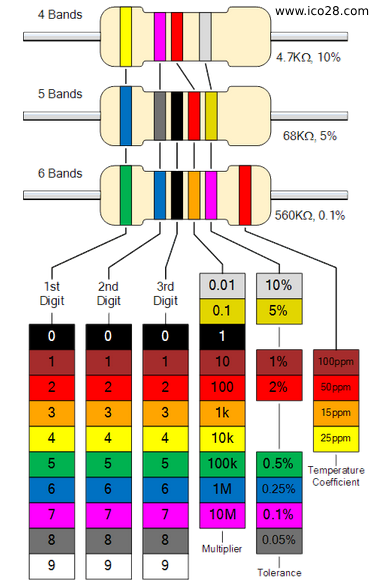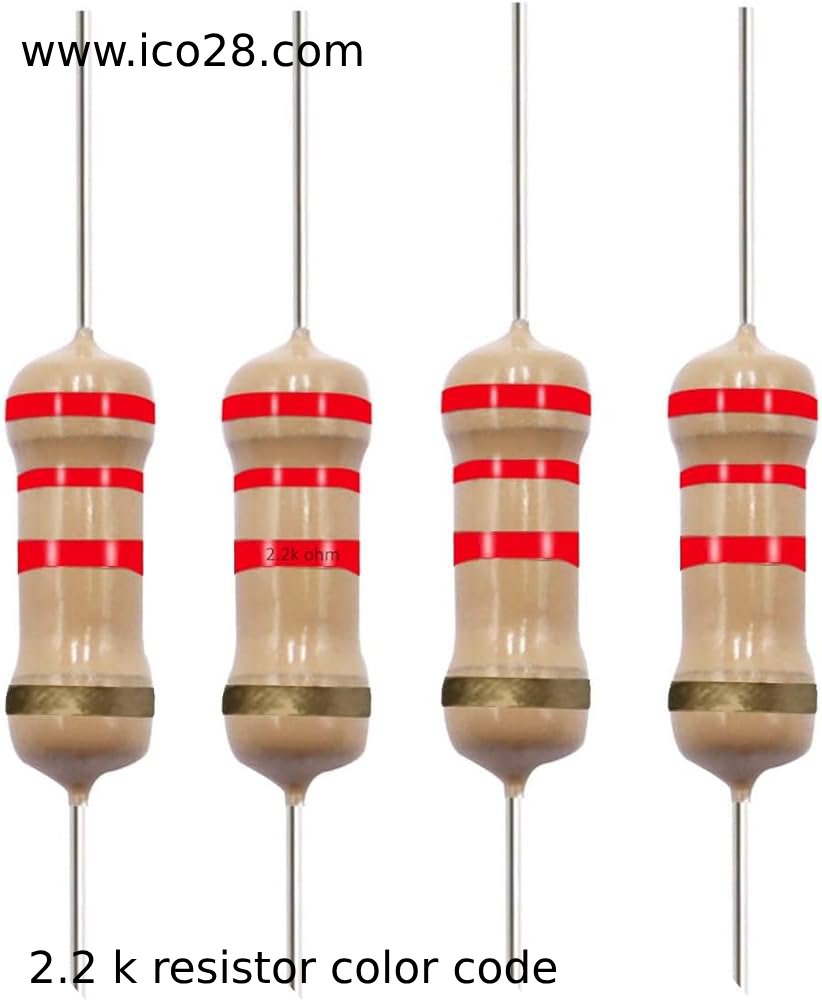I. Introduction
A universal technique for indicating a resistor’s resistance value, tolerance, and occasionally its temperature coefficient is resistor color coding. The resistor specifications may be rapidly ascertained by engineers and practitioners because each color has a numerical value associated with it. We will go over how to interpret resistor color codes in detail in this guide, with an emphasis on the 2.2k resistor variation.
II. Basics of Resistor Color Coding
A. Explanation of Resistor Color Bands
Usually, resistors have bands of several colors, each of which stands for a distinct value or number. The most common resistors have four or five stripes, while the number of stripes vary based on the resistor specifications. Every color bar has a numerical value given to it, often ranging from 0 to 9, which adds to the resistor’s total resistance value. The resistor resistance value, tolerance, and occasionally the temperature coefficient can be ascertained by deciphering the color sequence and their placements.
B. Relationship Between Color Bands and Resistor Values
The Electronic Industries Association (EIA) produced a standard pattern for the correlation between resistor values and color bars. The resistance value’s significant digits are shown by the first two bars, the multiplier—the power of ten by which the significant digits are multiplied—by the third bar, and the tolerance level—for resistors with four bands—by the fourth bar. In five-band resistors, an additional band is used to represent the temperature coefficient. By understanding this relationship, one can decode the color bands to ascertain the resistance value of a resistor accurately.
C. Significance of Tolerance Band
The tolerance band, usually the last band on a resistor, indicates the allowable deviation from the nominal resistance value. It displays the resistor’s tolerance, or the range within which the resistance value in practice may vary from the value that is given. The tolerance is given as a percentage; typical ranges are 5%, 10%, and 1%. Higher accuracy is indicated by a smaller tolerance number, which also suggests that the resistor’s real resistance is closer to its rated value. It is crucial to comprehend the meaning of the tolerance band when choosing resistors that satisfy the required levels of precision for a particular application.

III. Interpreting 2.2k Resistor Color Code
A. Identification of Color Bands for 2.2k Resistance
When decoding the color bands of a 2.2k resistor, you’ll typically encounter four bands. The first two bands represent the significant digits of the resistance value, while the third band indicates the multiplier. The fourth band denotes the tolerance level. In the case of a 2.2k resistor, the colors on the bands will correspond to specific numerical values, which, when combined, yield the resistance value of 2.2kΩ.
B. Understanding the Meaning of Each Color Band
Each color band on a resistor corresponds to a particular digit or value. The first bar, for instance, indicates the first significant digit in the case of a 2.2k resistor; the second bar, the second significant digit; the multiplier, or the number of zeros added to the significant digit; and the tolerance level, the fourth bar. It is possible to precisely calculate the resistor resistance value and tolerance by comprehending the meaning of each color bar.
C. Determining the Value and Tolerance of a 2.2k Resistor
The resistance value in ohms must be obtained by decoding the colors of the first three bars in order to calculate the value of the 2.2k resistor using this color code. The tolerance level is shown in the fourth bar. By adding the significant digits and multiplying by a factor, you can determine the resistance value once you have determined the color bars and their related values. You can gauge the correctness of the resistor value by looking at the tolerance bar, which shows the tolerance deviation from the nominal resistance value. Comprehending this procedure is essential for precise resistor selection and use in electrical circuits.

IV. Common Mistakes and Troubleshooting
A. Potential Errors in Reading Resistor Color Code
Errors in resistor color code reading can occur for a number of reasons, including inadequate lighting, color blindness, or confusion between colors that are similar. False readings can result from misinterpreting color bars or from failing to notice minor variances in shade, which can affect how accurately resistor values are detected.
B. Strategies for Accurate Interpretation
To ensure accurate interpretation of resistor color codes, several strategies can be employed. Using a magnifying glass or a smartphone camera with zoom capabilities can help in closely examining the color bands. Additionally, referencing color code charts or online calculators can provide confirmation of readings and mitigate errors. Double-checking readings and seeking assistance from colleagues or online communities can also improve accuracy.
C. Troubleshooting Tips for Identifying Resistor Values
When facing challenges in identifying resistor values, troubleshooting tips can be beneficial. Verifying readings with multiple sources, such as datasheets or manufacturer specifications, can help validate the accuracy of identified values. In cases of uncertainty, testing the resistor’s resistance with a multimeter can provide a direct measurement, serving as a reliable backup method for confirmation. Additionally, consulting with experienced professionals or seeking guidance from online forums can offer valuable insights and assistance in resolving identification issues. Employing these troubleshooting strategies can enhance accuracy and reliability in identifying resistor values.
V. Practical Applications
A. Examples of Circuits Using 2.2k Resistors
2.2k resistors find widespread use in various electronic circuits. For instance, they are commonly employed in voltage dividers, signal conditioning circuits, and biasing circuits. In voltage divider configurations, 2.2k resistors help attenuate voltage levels or establish reference voltages, contributing to signal processing and control functions in circuits.
B. Using Color Code to Select Resistors for Specific Applications
Understanding resistor color codes facilitates the selection of appropriate resistors for specific applications. By accurately interpreting color bands, engineers and hobbyists can choose resistors with desired resistance values and tolerance levels to meet the requirements of their circuits. Whether it’s for precision measurement circuits, voltage regulation, or signal amplification, the color code aids in selecting resistors that ensure optimal performance and reliability.
C. Real-World Scenarios Illustrating the Importance of Accurate Resistor Identification
In real-world situations, accurate resistor detection is essential for preventing circuit failures, guaranteeing appropriate circuit performance, and preserving system integrity. In electronic equipment, inaccurate resistor values can lead to component failure, signal distortion, and voltage fluctuations. For instance, precise resistor values are necessary to provide reliable and secure functioning in the aerospace and medical industries, where dependability is crucial. Therefore, color coding can be used to precisely identify resistors in a variety of real-world applications across multiple industries.

VI. Conclusion
Mastering the 2.2k resistor color code is essential for anyone working with electronic circuits. It enables accurate identification of resistor values, ensuring proper selection and implementation in circuit designs. Proficiency in resistor color coding enhances efficiency, reduces errors, and promotes reliable circuit operation, thereby contributing to the overall success of electronic projects.
